CATHEDRAL QUEST
Our quest to experience the great cathedrals and churches of Europe
Day
4 Friday, May 25th 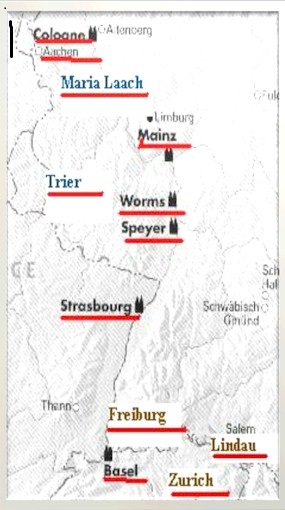
Maria
Laach to Mainz
We
had another good breakfast in our hotel after which we packed up and checked
out. We carried our suitcases
through the train station to Avis Car Rental, which was in the train station.
We had booked a subcompact VW with stick shift - very economical.
When we checked in the representative asked if we would like to have an
automatic Mercedes Diesel for the same price.
We said we would have to “seriously think about it!!!!!”
It was a cute little A180 CDI, like a small station wagon. It was black.
We hooked up the TomTom and off we went.
Before we had gone too far we were in the construction near our hotel and
made a wrong turn, but the TomTom got us right back on track.
It took us right to Maria Laach without a problem.
We had set it for kilometers so we had to learn the distance in
kilometers, which we are not sure we ever did.
Maria
Laach was in a beautiful setting, not far from the river.
There was a large parking lot across the road with a tunnel to the abbey.
It looked just like the
model in every way, even to the little fountain.
They were doing some repair work on the courtyard.
It was beautiful inside. Monks
were leaving as we arrived.
GERMANY
CATHEDRAL ARCHITECTURE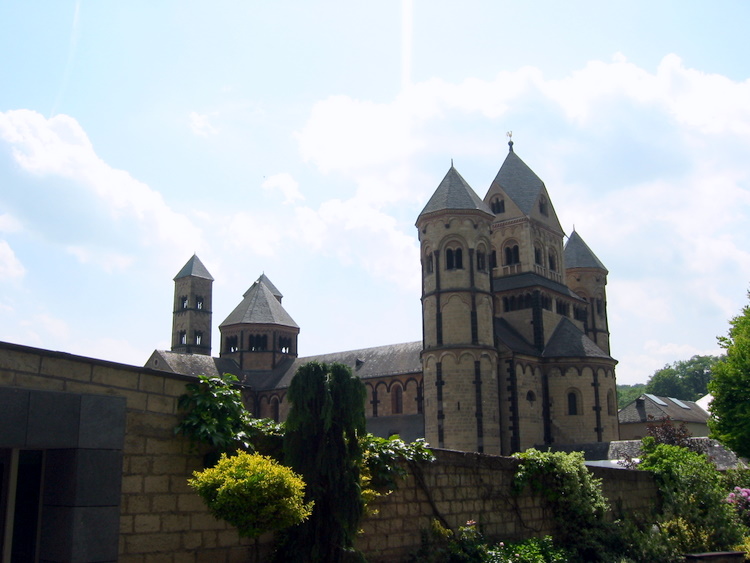
Most
of the German churches that we will visit will be very similar to Maria Laach in
an architectural style which is different from the French Gothic and even the
old Romanesque churches in Cologne and the Gothic Cologne cathedral.
One of the first differences that we noticed, first in Maria Laach, was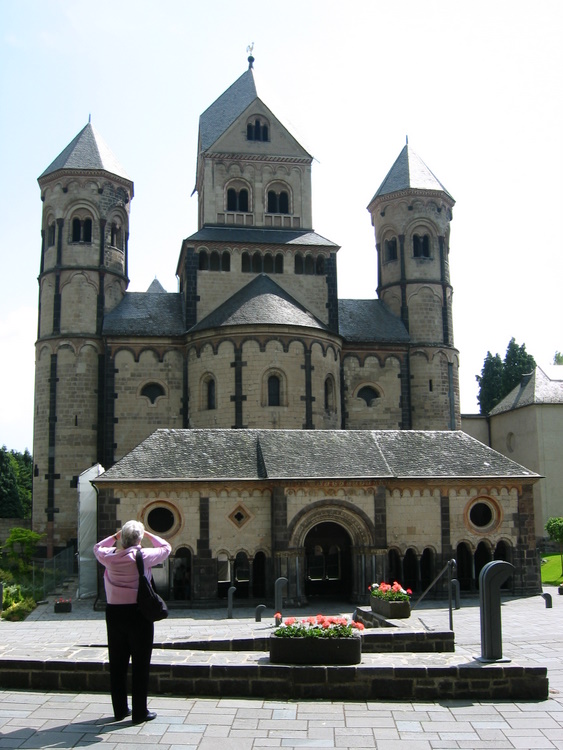 the
rounded front, a structure much like the apse in the rear of French Gothic
cathedrals. There was also a
matching apse in the rear of the church. Most
German church that we will visit in the next week will, like Maria Laach, have a
pair of towers in the front and a pair in the rear plus one or more domes
– one in the front, often one in the middle and sometimes a third on in the
rear. There was no ornate west front with door surrounded by statues.
Most of the entrances are either to the right or left o
the
rounded front, a structure much like the apse in the rear of French Gothic
cathedrals. There was also a
matching apse in the rear of the church. Most
German church that we will visit in the next week will, like Maria Laach, have a
pair of towers in the front and a pair in the rear plus one or more domes
– one in the front, often one in the middle and sometimes a third on in the
rear. There was no ornate west front with door surrounded by statues.
Most of the entrances are either to the right or left o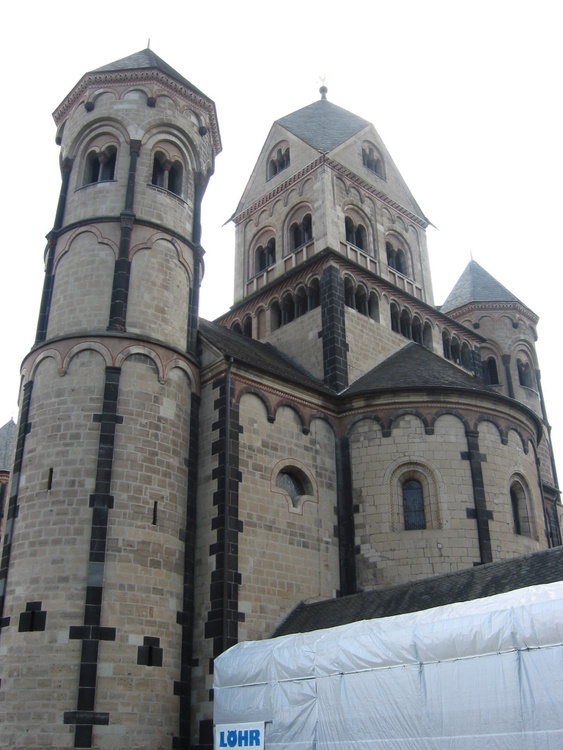 f
the front apse with rather plain doors.
f
the front apse with rather plain doors.
ABBEY MARIA LAACH
Abbey
Maria
Laach was founded by Heinrich II in 1093. The church was consecrated in 1156.
During the 12th century, the west and east sides were completed.
In 1802 the abbey was closed due to secularization.
Again we find fire striking, and in1855 most of the building was
consumed. Almost 40 years later, in
1892, the monks returned.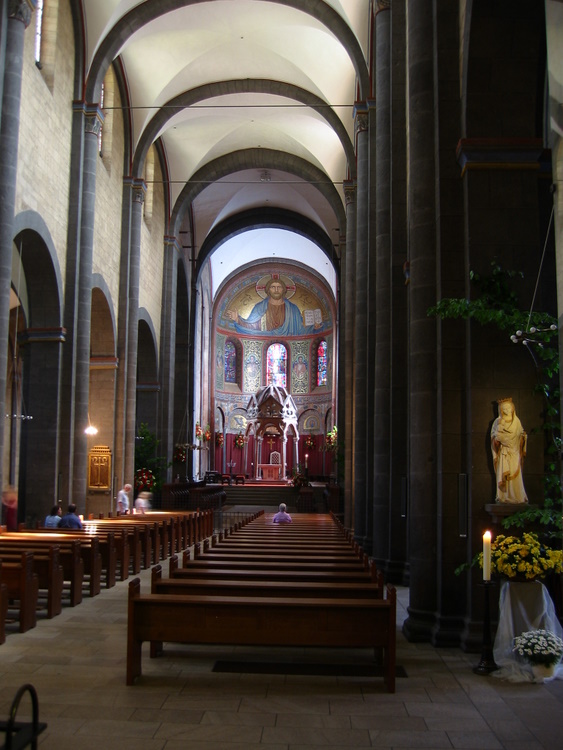
The
interior was very Romanesque with round arches, a clerestory with clear glass
windows. There was a groin vaulted ceiling. The Apse was almost entirely
mosaic with a very large bust of Christ at the top with outreached
arms. There was a baldachin over the altar. The opposite end
of the church was anot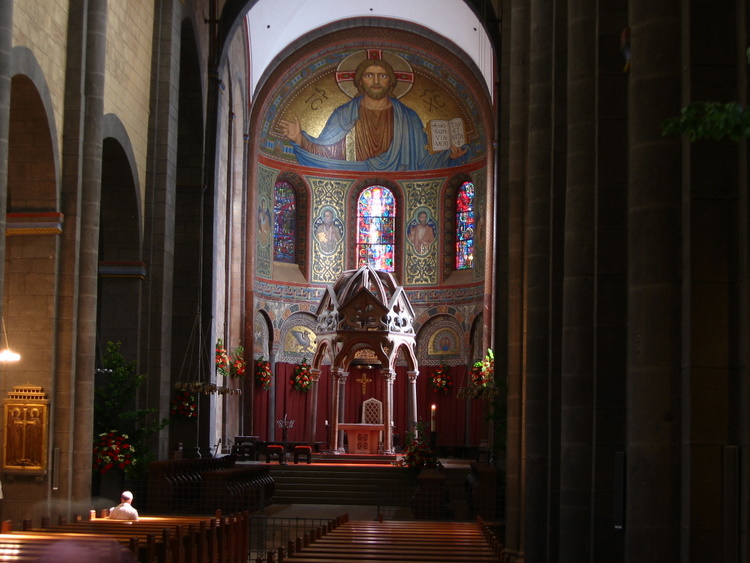 her
apse as we will see in other German churches. This apse was the choir. SEE
MY MODEL OF MARIA LAACH
her
apse as we will see in other German churches. This apse was the choir. SEE
MY MODEL OF MARIA LAACH
A few yards from the Abbey was a gift store and a large hotel with several restaurants. We ate out in the Beirgarten. We both had Bratworst and brochen and water for 8€. There was no beer in the beergarden today!!
MAINZ
Looking
at our time, we decided not to go to Koblenz, even though it was very close.
So we headed to Mainz. We got
to Mainz at 3:50 and found our hotel, Ibis.
We had a cute little room with double doors.
We took off walking towards the old town and the Dom,
passing
passed two Baroque churches –St. Ignatius and St. Augustine - and
stopped and took pictures.
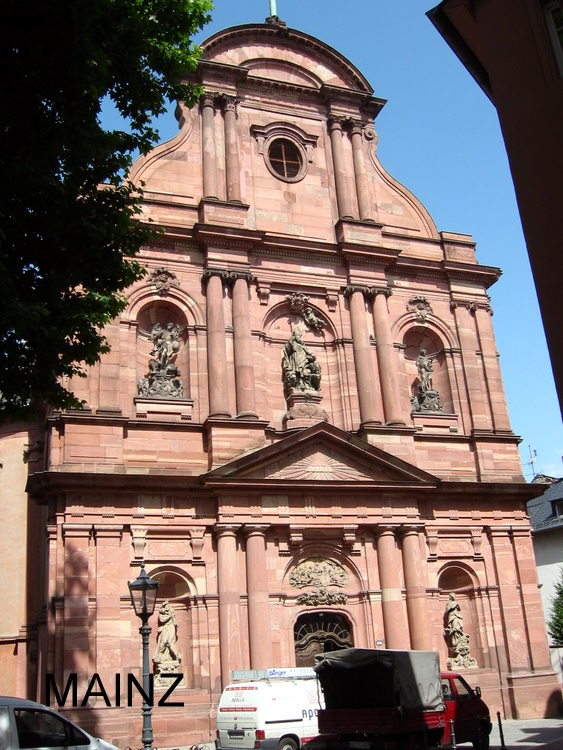
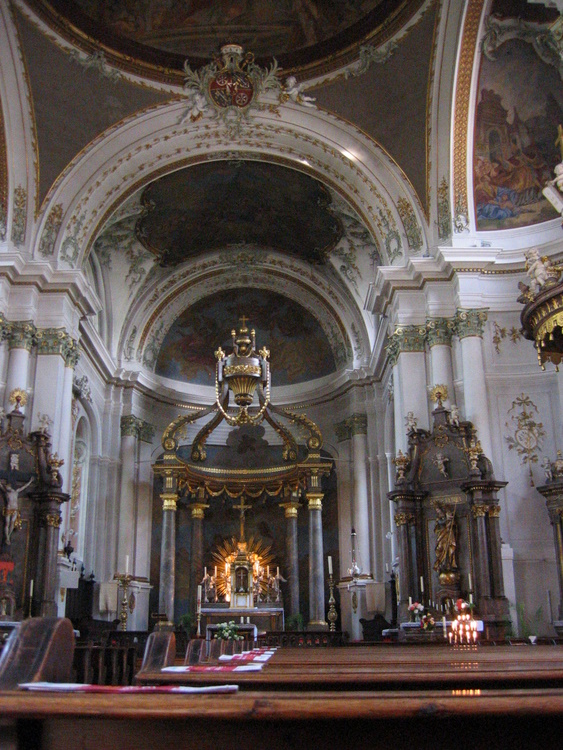
St.
Ignatius Church was built between
1763 and 1675 on the site of a previous parish church.
The Cross shaped church, designed by Johann Peter Jager, is consecrated
to Ignatius, the martyr and Bishop of Antioch.
A sculpture of St. Ignatius, a Last Supper relief, and four alcove
figures adorn the façade. The ceiling mural in the interior of the church was
produced in 1773-74, over painted in 1902 and restored in 1953-55.
The freestanding baldachin altar was completed in 1784.
The Augustinian Church
The
Augustinian Church and Monastery was
first built by Augustinians in 1260-87. This
was replaced by the present church. In
1805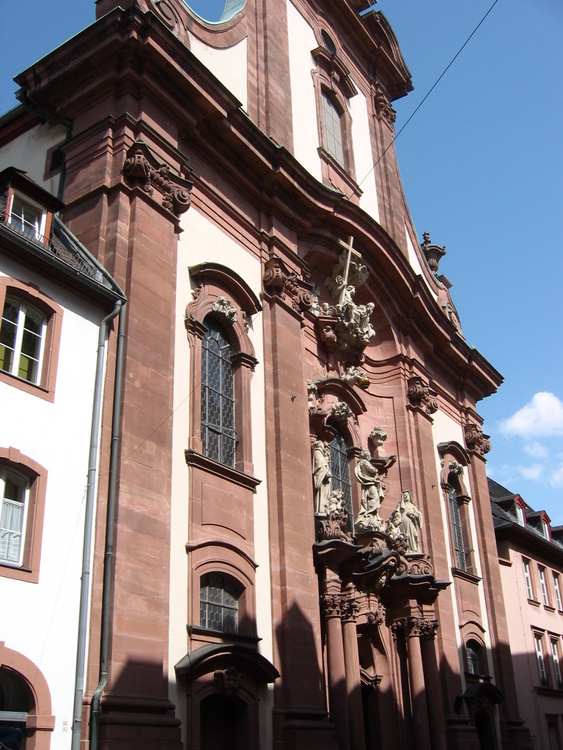 it became the Bishop’s Seminary
Church, and in 1851 after a murder was committed in the church, it was reconsecrated.
The church is enclosed by buildings on three sides.
On its façade above the portal is a depiction of the crowning of Mary,
flanked by St. A
it became the Bishop’s Seminary
Church, and in 1851 after a murder was committed in the church, it was reconsecrated.
The church is enclosed by buildings on three sides.
On its façade above the portal is a depiction of the crowning of Mary,
flanked by St. A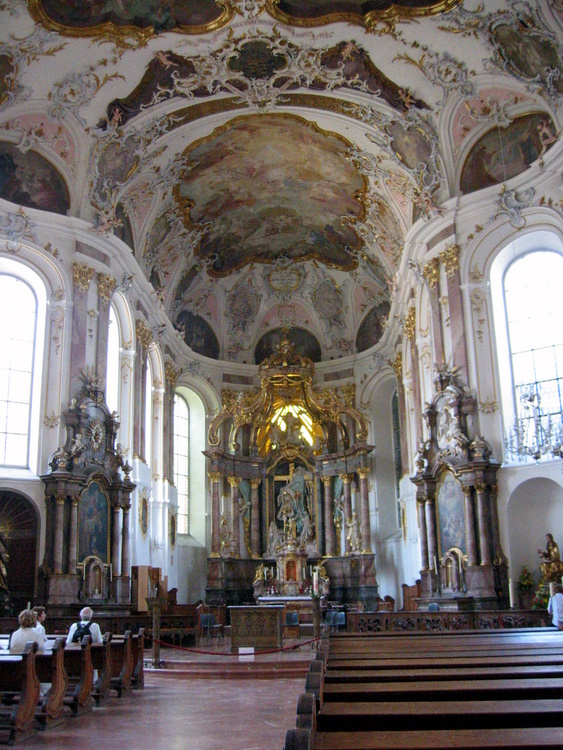 ugustine
and St. Monica with the Holy Trinity above on a throne.
In 1772, the painter Johann Baptist Enderle portrayed the baptism and
glorification of St. Augustine in what is now the only originally preserved
ceiling mural in any of Mainz’s Baroque or Rococo churches.
ugustine
and St. Monica with the Holy Trinity above on a throne.
In 1772, the painter Johann Baptist Enderle portrayed the baptism and
glorification of St. Augustine in what is now the only originally preserved
ceiling mural in any of Mainz’s Baroque or Rococo churches.
We
walked on further to the cathedral. It
was very large, with a chancel or apse at both ends, like Maria Laach.
MAINZ
CATHEDRAL
Willigis
was appointed Archbishop of Mainz in 975. He
ordered construction of new cathedral. This
cathedral suffered extensive damage in fire on the d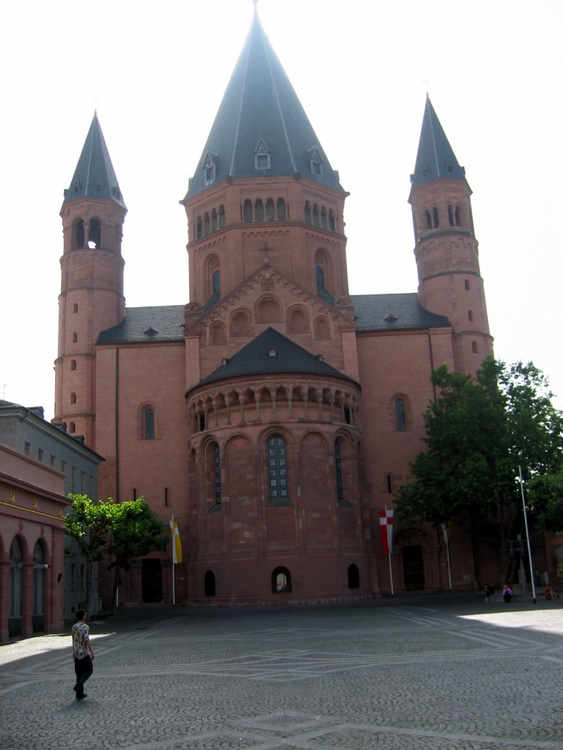 ay
of its inauguration in 1009. The main portions were completed in 1037and in 1081
fire struck again. Henry IV ordered
reconstruction in 1100 in old Lombardic style but Henry IV died in 1106 before
changed completed and construction was abandoned.
ay
of its inauguration in 1009. The main portions were completed in 1037and in 1081
fire struck again. Henry IV ordered
reconstruction in 1100 in old Lombardic style but Henry IV died in 1106 before
changed completed and construction was abandoned.
It
was not until the 12th century that the nave had further
construction. Gothic additions were made bet ween
1239 -1418. In 1767 the western tower was struck by lightning and its roof
destroyed. Other parts were destroyed in 1803.
ween
1239 -1418. In 1767 the western tower was struck by lightning and its roof
destroyed. Other parts were destroyed in 1803.
Bishop
Colma, with support from Napoleon, started restoration of the cathedral.
Finally it was used at as church in 1814, first time in eleven years. The
repairs were completed 1831. In August of 1942, during WWII ,the cathedral
suffered several hits. Most of the
roof was burned and top level of cloister was destroyed.
Vault was unharmed.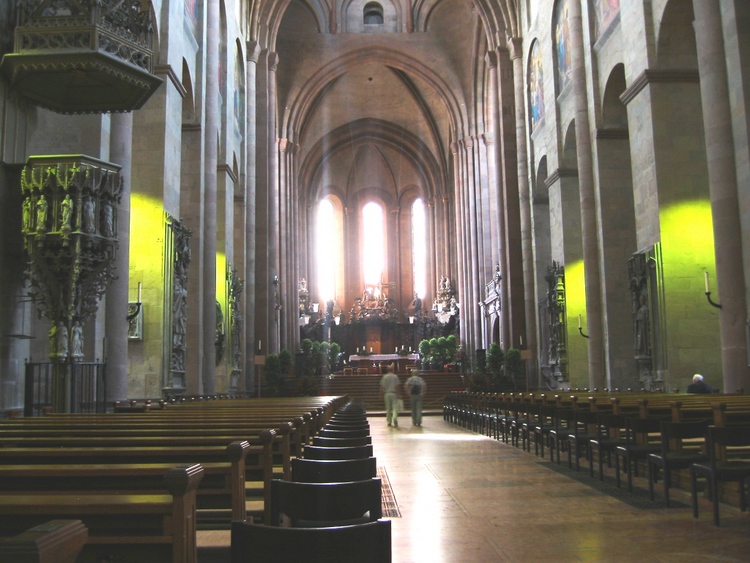
The
churc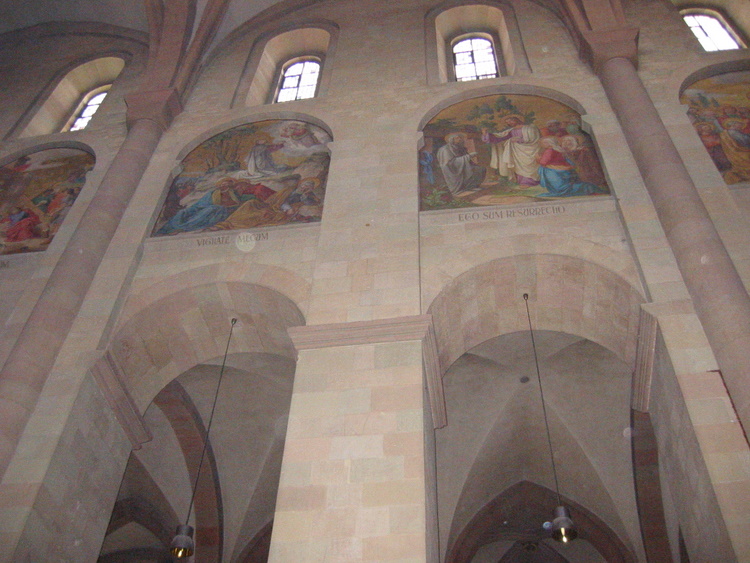 h
was rather dark inside. It was
Romanesque…rounded arches and square pillars. Note that the exterior
above shows that there are no flying buttresses. The side aisle are rather
tall and the roof extends to right under the clerestory windows. The photo
on the left shows that the wall area between the arches and the clerestory
windows contains a series of large paintings of the life Christ. In
other cathedrals, this area often would contain windows.
h
was rather dark inside. It was
Romanesque…rounded arches and square pillars. Note that the exterior
above shows that there are no flying buttresses. The side aisle are rather
tall and the roof extends to right under the clerestory windows. The photo
on the left shows that the wall area between the arches and the clerestory
windows contains a series of large paintings of the life Christ. In
other cathedrals, this area often would contain windows.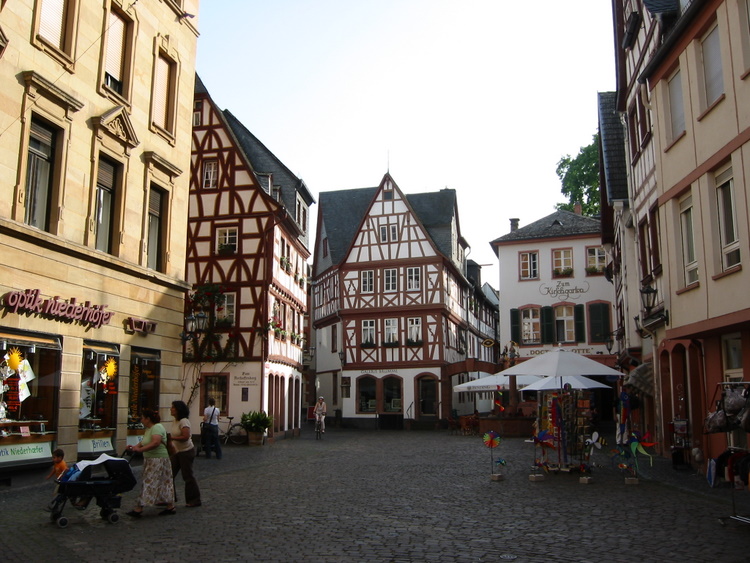
We
walked back to the hotel, stopping at a cute little vine shop for some German
wine. We went back to the hotel and
then to the river which was a little over a block away.
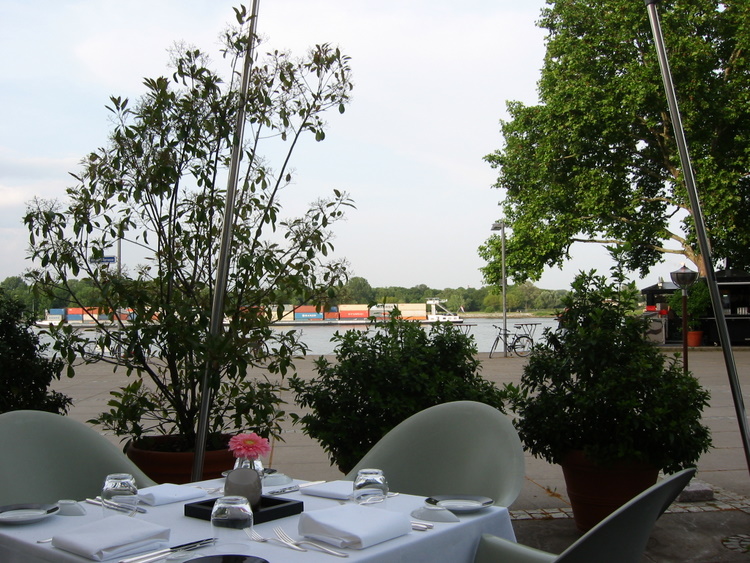
We
ate dinner on the outdoor terrace at the Hilton. We
had a nice view of the river and could see barges going up and down.
Part of the hotel was a section of the old Roman wall and fort.
We didn’t write down what we ate.
